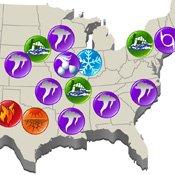Monday, January 23, 2012
It was very hot last year. In fact, 2011 broke records for climate extremes, as the U.S. battled historic levels of heat, precipitation, flooding and severe weather, according to scientists from the National Oceanographic and Atmospheric Administration.
To be precise, the average temperature in the contiguous United States was 53.8 degrees Fahrenheit, one degree over the 20th century average, making 2011 the 23rd warmest on record in the U.S.
Globally, "La Nina events helped keep the average global temperature below recent trends. As a result, 2011 tied with 1997 for the 11th warmest year on record. It was the second coolest year of the 21st century to date, and tied with the second warmest year of the 20th century," said a NOAA news release.
But the warmer temperatures meant more than great beach weather. Severe weather also makes a big impact on utility companies and their ratepayers.
NOAA observed 14 weather events that caused damage totaling $1 billion or more, including a spate of tornadoes that swept across the southeast and midwest last April and Tropical Storm Lee, which barreled into the Gulf Coast in early September.
In Mississippi, the April 2011 storms knocked out power for at least 13,000 Entergy customers while Tropical Storm Lee left more than 4,000 Mississippians without electricity. Entergy also sent crews to help with weather disasters in other parts of the country.
Twenty-one people died in Tropical Storm Lee, including one in Mississippi.
NOAA's other U.S. climate-related findings include:
• Warmer-than-normal temperatures anchored across the south, mid-Atlantic and the northeast. Delaware had its warmest year on record, while Texas had its second warmest year on record. The U.S. has observed a long-term temperature increase of about 0.12 degrees F per decade since 1895.
• Summer (June to August) 2011 was the second-warmest on record for the lower 48 states, with an average temperature of 74.5 degrees F, just 0.1 degree F below the record-warm summer of 1936. The epicenter of the heat was the Southern Plains, where Louisiana, New Mexico, Oklahoma and Texas all had their warmest summer on record. The three-month average temperatures for Oklahoma (86.9 degrees F) and Texas (86.7 degrees F) surpassed the previous record for warmest summer in any state.
• With the exception of Vermont, each state in the contiguous U.S. had at least one location that exceeded 100 degrees F. Summertime temperatures have increased across the U.S. at an average rate of 0.11 degrees F per decade. Much of this trend is due to increases in minimum temperatures ("overnight lows"), with minimum temperature extremes becoming increasingly commonplace in recent decades.
• Despite a "near normal" national precipitation average, regional precipitation outcomes varied wildly. Texas, ravaged by exceptional drought for most of 2011, had its driest year on record. In contrast, seven states in the Ohio Valley and northeast-- Connecticut, Indiana, Kentucky, New Jersey, New York, Ohio, and Pennsylvania -- had their wettest year on record.
• The past nine years have been particularly wet across the northeast region. Since 2003, the annual precipitation for the region is 48.96 inches, 7.88 inches above the 20th-century average. The precipitation average across the U.S. is increasing at a rate of about 0.18 inches per decade.
• Precipitation extremes and impacts were most prevalent during spring (March to May) 2011. Across the northern U.S., 10 states were record wet, and an additional 11 states had spring precipitation totals ranking among their top 10 wettest. These precipitation extremes, combined with meltwater from a near-record snow pack, contributed to historic flooding along several major rivers across the central United States.
• Meanwhile, drought rapidly intensified in the southern Plains, where Texas had only 2.66 inches of precipitation, its driest spring on record. This led to record-breaking drought and wildfires, which devastated the southern Plains. Following 2010, during which drought across the country was nearly erased, the 12 percent of the continental U.S. in the most severe category of drought (D4) during July 2011 was the highest in the U.S. Drought Monitor era (1999 to 2011).
• The spring brought a record-breaking tornado season to the United States. Over 1,150 tornadoes were confirmed during the March through May period. The 551 tornado-related fatalities during the year were the most in the 62-year period of record. The deadliest tornado outbreak on record (April 25 to April 28) and the deadliest single tornado (Joplin, Missouri) contributed to the high fatality count.

Comments
Use the comment form below to begin a discussion about this content.
Sign in to comment
Or login with:
OpenID